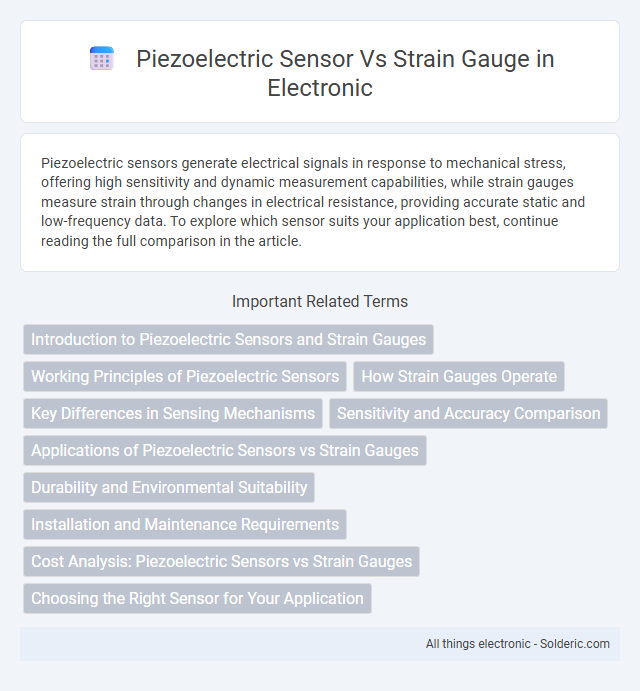Piezoelectric sensors generate electrical signals in response to mechanical stress, offering high sensitivity and dynamic measurement capabilities, while strain gauges measure strain through changes in electrical resistance, providing accurate static and low-frequency data. To explore which sensor suits your application best, continue reading the full comparison in the article.
Comparison Table
| Feature | Piezoelectric Sensor | Strain Gauge |
|---|---|---|
| Measurement Principle | Generates electric charge under mechanical stress | Changes electrical resistance when strained |
| Output Signal | Charge or voltage | Resistance change (requires Wheatstone bridge) |
| Frequency Response | High frequency (up to MHz) | Low to medium frequency |
| Static Measurement Capability | Not suitable for static; dynamic only | Suitable for static and dynamic strain |
| Sensitivity | High sensitivity to dynamic forces | High sensitivity to strain |
| Temperature Range | Wide temperature range, depends on material | Limited, requires temperature compensation |
| Size and Durability | Compact and robust | Thin and delicate, surface mounted |
| Applications | Vibration monitoring, impact detection | Structural health monitoring, stress analysis |
| Cost | Moderate to high | Low to moderate |
Introduction to Piezoelectric Sensors and Strain Gauges
Piezoelectric sensors generate electrical charge in response to mechanical stress using materials like quartz or ceramics, offering high-frequency dynamic force measurement ideal for vibration and impact monitoring. Strain gauges measure strain by changing electrical resistance in a conductive foil or wire attached to a structure, providing precise static and low-frequency deformation data. Both sensors are essential in structural health monitoring, but piezoelectric sensors excel in dynamic applications, while strain gauges are preferred for static or slowly varying loads.
Working Principles of Piezoelectric Sensors
Piezoelectric sensors generate electrical charge in response to mechanical stress, utilizing materials like quartz or ceramics that exhibit piezoelectric effects. Unlike strain gauges, which measure deformation through changes in electrical resistance, piezoelectric sensors convert dynamic pressure, force, or vibration into proportional voltage signals without requiring power sources. Your choice depends on the application's need for dynamic versus static measurement capabilities and the sensor's sensitivity to rapid changes.
How Strain Gauges Operate
Strain gauges operate by measuring the change in electrical resistance as a material deforms under stress, which directly correlates to the strain experienced. These sensors typically use a thin metallic foil pattern laminated onto a flexible backing; when the substrate stretches, the foil's length increases and cross-sectional area decreases, causing resistance to vary. The resistance change is then converted into an electrical signal, allowing precise quantification of mechanical strain in structures or materials.
Key Differences in Sensing Mechanisms
Piezoelectric sensors generate an electrical charge in response to dynamic mechanical stress or vibrations, utilizing the direct piezoelectric effect in materials like quartz or ceramics. Strain gauges measure static or slowly varying strain by detecting changes in electrical resistance caused by deformation of a metallic foil or semiconductor element bonded to the surface. Unlike strain gauges, piezoelectric sensors cannot measure static strain since their charge dissipates over time, making each ideal for different applications based on sensing requirements.
Sensitivity and Accuracy Comparison
Piezoelectric sensors exhibit high sensitivity to dynamic strain and rapid pressure changes, making them ideal for applications requiring precise vibration and impact measurements. Strain gauges offer superior accuracy for static or slowly varying loads due to their linear response and stable output over time. Your choice between the two depends on whether you prioritize dynamic sensitivity with piezoelectric sensors or static accuracy with strain gauges.
Applications of Piezoelectric Sensors vs Strain Gauges
Piezoelectric sensors are widely used in dynamic force, pressure, and vibration measurements, particularly in automotive crash testing, industrial monitoring, and medical ultrasound devices due to their high-frequency response and ability to detect rapid changes. Strain gauges excel in static and low-frequency strain measurements, making them essential for structural health monitoring in bridges, aircraft, and machinery where precise deformation tracking under steady loads is critical. The choice between piezoelectric sensors and strain gauges depends on application requirements such as frequency range, sensitivity, and environmental conditions.
Durability and Environmental Suitability
Piezoelectric sensors exhibit high durability with excellent resistance to shock and vibration, making them ideal for harsh environmental conditions such as high temperatures and corrosive atmospheres. Strain gauges, while accurate and sensitive, typically require protective coatings to withstand moisture and chemical exposure, limiting their long-term durability in harsh environments. The intrinsic robustness of piezoelectric materials often results in longer operational lifespans and reduced maintenance compared to strain gauge setups in industrial applications.
Installation and Maintenance Requirements
Piezoelectric sensors require minimal installation effort due to their compact size and often non-contact measurement capabilities, making them suitable for dynamic force or vibration monitoring with little maintenance. Strain gauges typically demand precise surface preparation and secure adhesive bonding, leading to more complex installation and periodic calibration or inspection to ensure accuracy. Your choice depends on the application's tolerance for maintenance frequency and ease of sensor replacement.
Cost Analysis: Piezoelectric Sensors vs Strain Gauges
Piezoelectric sensors typically have a higher initial cost compared to strain gauges due to their complex materials and manufacturing processes. Strain gauges offer a more cost-effective solution for static or low-frequency measurements, making them ideal for budget-sensitive applications. However, piezoelectric sensors provide better performance in dynamic and high-frequency environments, which can justify their higher price in specialized industrial or research settings.
Choosing the Right Sensor for Your Application
Piezoelectric sensors excel in dynamic-force measurement with high-frequency sensitivity and fast response, making them ideal for vibration and impact analysis. Strain gauges provide precise static and low-frequency strain measurements, offering stable and accurate readings for structural health monitoring. Selecting between these sensors depends on the application's frequency range, measurement type, and environmental conditions.
piezoelectric sensor vs strain gauge Infographic

 solderic.com
solderic.com